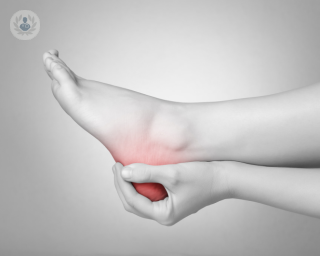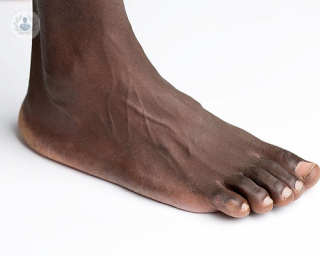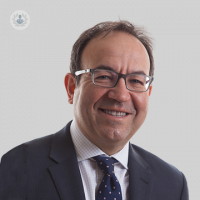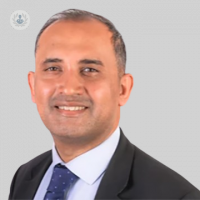The foot is a complex structure consisting in dozens of bones, joints, muscles, ligaments, and over a hundred tendons. Properly functioning feet are essential to walking and standing unaided.
Our feet must fulfil four basic functions:
- act as a rigid lever to create the propulsive force needed for walking
- transfer the rotational forces produced by the hip
- adapt to uneven surfaces
- absorb impact against the ground
To fulfil these functions, the muscles and tendons must work together with bones, ligaments and joints. If one of these components does not function properly, all others will be affected.

Pathologies that the foot may suffer
Because the human foot has so many parts, over time we have distinguished a wide range of pathologies related to the foot. Some of the most common conditions affecting the foot include:
- Ankle and heel problems – plantar fascitis, heel spur, Achilles tendinopathy, Sever’s disease, Haglund's disease
- Problems with the structure of the foot – cavus foot, flat foot, club foot
- Toe problems – bunions, ingrown toenail, hammer toe, claw toe, corns
- Problems on the bottom of the foot – Morton’s neuroma, plantar warts, metatarsalgia, stress fracture
- Problems that can affect anywhere on the foot, such as rheumatoid arthritis
Treatments for foot pathologies
Soft tissue injuries and pathologies can sometimes be treated with anti-inflammatory medication, physiotherapy, or extracorporeal shockwave therapy
Foot surgery may sometimes recommended for hammer toe, claw toe, bunions, structural foot problems, or neurological problems. In addition to open surgery, new techniques such as percutaneous foot surgery have been developed in recent years involving smaller incisions and fewer post-surgical complications.
Specialist who treats foot pathologies
Podiatrists specialise in the examination, assessment, and treatment of foot problems. If you see your GP about a foot problem and they are unable to make a diagnosis themselves they are likely to refer you to a podiatrist. In the UK podiatrists are also known as chiropodists.
Depending on the treatment recommended, you may also see a physiotherapist, radiologist, or orthopaedic surgeon.
11-13-2012 10-16-2023Foot
Mr Jasdeep Giddie - Orthopaedic surgery
Created on: 11-13-2012
Updated on: 10-16-2023
Edited by: Aoife Maguire
The foot is a complex structure consisting in dozens of bones, joints, muscles, ligaments, and over a hundred tendons. Properly functioning feet are essential to walking and standing unaided.
Our feet must fulfil four basic functions:
- act as a rigid lever to create the propulsive force needed for walking
- transfer the rotational forces produced by the hip
- adapt to uneven surfaces
- absorb impact against the ground
To fulfil these functions, the muscles and tendons must work together with bones, ligaments and joints. If one of these components does not function properly, all others will be affected.

Pathologies that the foot may suffer
Because the human foot has so many parts, over time we have distinguished a wide range of pathologies related to the foot. Some of the most common conditions affecting the foot include:
- Ankle and heel problems – plantar fascitis, heel spur, Achilles tendinopathy, Sever’s disease, Haglund's disease
- Problems with the structure of the foot – cavus foot, flat foot, club foot
- Toe problems – bunions, ingrown toenail, hammer toe, claw toe, corns
- Problems on the bottom of the foot – Morton’s neuroma, plantar warts, metatarsalgia, stress fracture
- Problems that can affect anywhere on the foot, such as rheumatoid arthritis
Treatments for foot pathologies
Soft tissue injuries and pathologies can sometimes be treated with anti-inflammatory medication, physiotherapy, or extracorporeal shockwave therapy
Foot surgery may sometimes recommended for hammer toe, claw toe, bunions, structural foot problems, or neurological problems. In addition to open surgery, new techniques such as percutaneous foot surgery have been developed in recent years involving smaller incisions and fewer post-surgical complications.
Specialist who treats foot pathologies
Podiatrists specialise in the examination, assessment, and treatment of foot problems. If you see your GP about a foot problem and they are unable to make a diagnosis themselves they are likely to refer you to a podiatrist. In the UK podiatrists are also known as chiropodists.
Depending on the treatment recommended, you may also see a physiotherapist, radiologist, or orthopaedic surgeon.


Flat feet in children: Is correction always necessary?
By Mr Nigel Kiely
2024-12-18
The condition of flat feet in children is very common but some may need special support if they experience pain or discomfort. In this article, highly esteemed consultant orthopaedic surgeon Mr Nigel Kiely, who specialises in paediatric orthopaedics, explains when flat feet in children needs treatment and what options are available. See more


The consequences of leaving plantar fasciitis untreated
By Mr Edward Dawe
2024-12-18
Plantar fasciitis is a repetitive strain injury that causes pain and discomfort on the bottom of your foot, around the heel and arch. While simple at-home treatments can usually resolve it, if it's left untreated it can become a chronic condition and lead to other foot problems. One of our top foot and ankle surgeons, Mr Edward Dawe explains more. See more


What is a foot and ankle specialist?
By Mr Rohit Madhav
2024-12-17
From sprains and strains to bunions and breaks, a foot and ankle specialist is a type of orthopaedic surgeon, who, while dealing primarily with one part of the body, will treat a wide variety of physical problems. In this interview, expert and Top Doctor Mr Rohit Madhav explains what it means to be a foot and ankle specialist. See more


Why does the ball of my foot hurt?
By Mr Billy Jowett
2024-12-17
Foot pain comes in many shapes and forms and can be located in the heel, the arch, the toes or the ball of the foot. The latter, also known as metatarsalgia, can become worse when walking, and can make activity difficult. Orthopaedic surgeon Mr Billy Jowett is here to explain this condition: See more
Experts in Foot
-
Mr Jordi Sanchez-Ballester
Orthopaedic surgeryExpert in:
- Ankle
- Foot
- Knee arthroscopy
- Arthroplasty
- Knee surgery
- Osteoarthritis
-
Mr Barry Rose
Orthopaedic surgeryExpert in:
- Ankle
- Bunion (hallux valgus)
- Foot
- Sports injuries
- Achilles tendon
- Plantar fasciitis
-
Mr Howard Davies
Orthopaedic surgeryExpert in:
- Foot
- Ankle
- Ankle replacement surgery
- Sports injuries
- Arthritis
- Painful foot
-
Mr Naveed Shaikh
Orthopaedic surgeryExpert in:
- Bunion (hallux valgus)
- Knee surgery
- Foot
- Knee replacement
- ACL reconstruction
- Ankle
-
Mr Ash Vasireddy
Orthopaedic surgeryExpert in:
- Ankle
- Fractured ankle
- Malunion fracture
- Foot
- Fractured shoulder
- Knee fracture
- See all

Sussex Premier Health Eastbourne
Sussex Premier Health Eastbourne
Eastbourne District General Hospital, Kings Drive, Eastbourne, East Sussex
No existe teléfono en el centro.
By using the telephone number provided by TOP DOCTORS, you automatically agree to let us use your phone number for statistical and commercial purposes. For further information, read our Privacy Policy
Top Doctors

Cleveland Clinic London Hospital
Cleveland Clinic London Hospital
33 Grosvenor Place, SW1X 7HY
No existe teléfono en el centro.
By using the telephone number provided by TOP DOCTORS, you automatically agree to let us use your phone number for statistical and commercial purposes. For further information, read our Privacy Policy
Top Doctors

Sheffield Orthopaedics Ltd
Sheffield Orthopaedics Ltd
Claremont Hospital, 401 Sandygate Rd, Sheffield
No existe teléfono en el centro.
By using the telephone number provided by TOP DOCTORS, you automatically agree to let us use your phone number for statistical and commercial purposes. For further information, read our Privacy Policy
Top Doctors
-
Sussex Premier Health Eastbourne
Eastbourne District General Hospital, Kings Drive, Eastbourne, East Sussex, EastbourneExpert in:
- Cataracts
- Eyelid surgery
- Joint preservation surgery
- Women’s health
- Urology
-
Cleveland Clinic London Hospital
33 Grosvenor Place, SW1X 7HY, Central LondonExpert in:
- Cardiology
- Colorectal surgery
- Minimal access surgery (keyhole surgery)
- Gallbladder surgery
- Diagnostic Imaging
- Ultrasound
-
Sheffield Orthopaedics Ltd
Claremont Hospital, 401 Sandygate Rd, Sheffield, SheffieldExpert in:
- Hip
- Orthopaedic surgery
- Orthopaedic spinal surgery
- Shoulder and elbow
- Joint replacement
- Most viewed diseases, medical tests, and treatments
- Ulnar nerve entrapment
- Peripheral nerve block
- Peripheral neuropathy
- Joint pain
- Lumbar herniated disc
- Spinal surgery
- Minimal access surgery (keyhole surgery)
- Shoulder pain
- Osteoporosis
- Botulinum toxin (Botox™)








